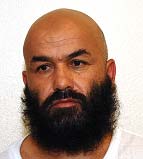|
|
|
Shawali Khan. |
On Tuesday, the DC Circuit Court affirmed a district court’s decision to reject Guantanamo detainee Shawali Khan’s petition for a writ of habeas corpus. Khan’s habeas petition was originally denied in September 2010. [See LWJ report, HIG facilitator properly detained at Gitmo, judge finds.] In each instance, the courts found that Khan (whose internment serial number is 899) was a facilitator for an Hizb-e-Islami Gulbuddin (HIG) IED cell in Kandahar until his capture in November 2002.
In his appeal, Khan challenged the lower court’s ruling, claiming that the court erred when it concluded he was a “part of” HIG and that the HIG was an “associated force” that works in conjunction with al Qaeda and the Taliban. The circuit court rejected Khan’s arguments on both counts, finding that three informants provided US military personnel reliable intelligence regarding Khan’s HIG membership. In addition, the court found that the HIG has long worked with al Qaeda and the Taliban.
The three “informants gave the [US] intelligence collectors quite specific information about the [HIG] cell’s method of operation,” the circuit court’s ruling reads. This intelligence included “the type of explosive device the cell employed, the cell’s use of two explosions to maximize casualties, the exact radio frequencies it used in a specific sequence to detonate the two explosions, and details about some of the cell’s intended targets.”
US military intelligence reports “originally contained as enclosures digital photographs of objects provided by the informants to the collectors,” including an “[HIG] explosive device” and an “[HIG] detonation device.”
One of the informants, according to the circuit court, “was a member of the HIG cell who came forward because he wanted to leave the cell as a result of an HIG attack that killed some of his tribesmen.” US forces “planned their operation to capture Khan based on” this informant’s tip.
Khan was so prolific, one of the US intelligence collectors noted, “that after Khan’s capture, IED attacks stopped in the area for about two months.”
The HIG, Taliban, Iran, and Pakistan
Khan’s HIG cell was commanded by his uncle, Zabit Jalil. The “informants and a Defense Department intelligence report said” Jalil “commanded HIG’s Kandahar cell from Pakistan,” according to the circuit court.
The Defense Department’s intelligence indicates “that, in August 2002, the Taliban and HIG opened a joint office in Pakistan to be led by” Jalil and a Taliban commander named Hafez Majid. “The purpose of the joint effort was to recruit new members and raise money for attacks on Afghan and US security forces.”
A leaked Joint Task Force Guantanamo (JTF-GTMO) threat assessment of Khan, dated Oct. 22, 2008, contains intriguing details about this “joint” effort.
Jalil and Majid “had the responsibility of maintaining HIG and Taliban connections with the Iranian government,” JTF-GTMO found. “They requested weapons and other supplies from Iran in order to conduct [Anti-Coalition Militia] attacks on US and Coalition forces.”
Iran granted their request. “During mid-2002, Iran gave $2,000,000 US and 3,000 AK-47 rifles to ACM elements in Afghanistan,” the JTF-GTMO file reads. “Iran has also provided explosives, computer-controlled mines, unidentified poisons, and unidentified chemical capsules to make bombs.”
JTF-GTMO concluded that Khan’s Kandahar “cell received some of the supplies” from Iran.
After Khan was captured, his uncle Jalil remained “active” in the insurgency, and the JTF-GTMO file contains intelligence reports detailing Jalil’s operations. In addition to conducting rocket and IED attacks inside Afghanistan, Jalil worked to free his jihadist brethren.
“In late November 2006,” JTF-GTMO’s analysts found, “the Pakistani government was alleged to have released Taliban prisoners through the arrangements of Zabit Jalil and through Jalil’s contact in Pakistan’s Inter-Services Intelligence.”
Jalil also continued to operate inside Pakistan. In May 2008, Jalil “reportedly met with HIG leader Gulbuddin Hekmatyar in Quetta.” During the meeting, “Hekmatyar provided Jalil with a suitcase containing an unknown amount of US currency.”
Jalil “received his orders” from two top Taliban commanders, according to JTF-GTMO. The first is Mullah Obaidallah Akhund, the Taliban’s former Defense Minister. Akhund operated inside Pakistan, with authorities there detaining him on occasion. His current status is uncertain. The second Taliban commander is Mullah Akhtar Muhammad Osmani, who “commanded the Kandahar military garrison for six years.” Osmani who was a member of the Taliban’s Quetta Shura, and prior to his death in 2006 was close to both Osama bin Laden and Mullah Omar.
A “high risk”
Despite his demonstrable ties to Jalil and the Kandahar IED cell, Khan did not admit his HIG role during interrogations at Guantanamo. “Detainee is not forthcoming with interrogators and is deceptive about his past and connections to the HIG,” JTF-GTMO reported. “Contrary to reporting, detainee denied he has close ties to his uncle Zabit Jalil, a known HIG leader.”
JTF-GTMO also determined that Khan is a “high risk, as he is likely to pose a threat to the US, its interests, and allies.” JTF-GTMO recommended that Khan remain in the Department of Defense’s custody, as opposed to being transferred to his home country of Afghanistan.
“Detainee would likely rejoin ACM elements and conduct operations against US and Coalition forces if released,” JTF-GTMO warned.









2 Comments
Yeah, no kidding. He’s a hardcore murderer.
Why all the prisoners look the same way lol.